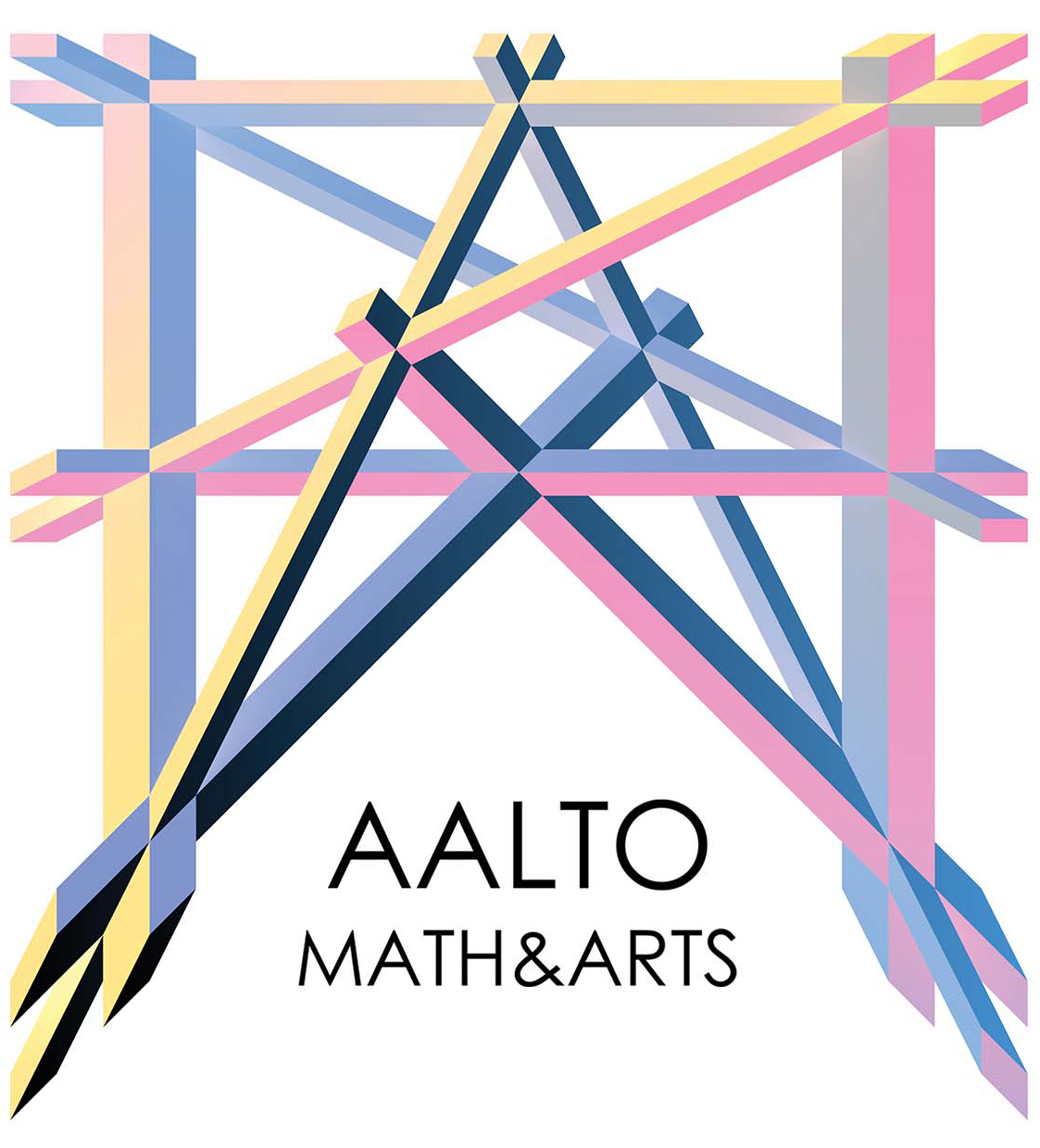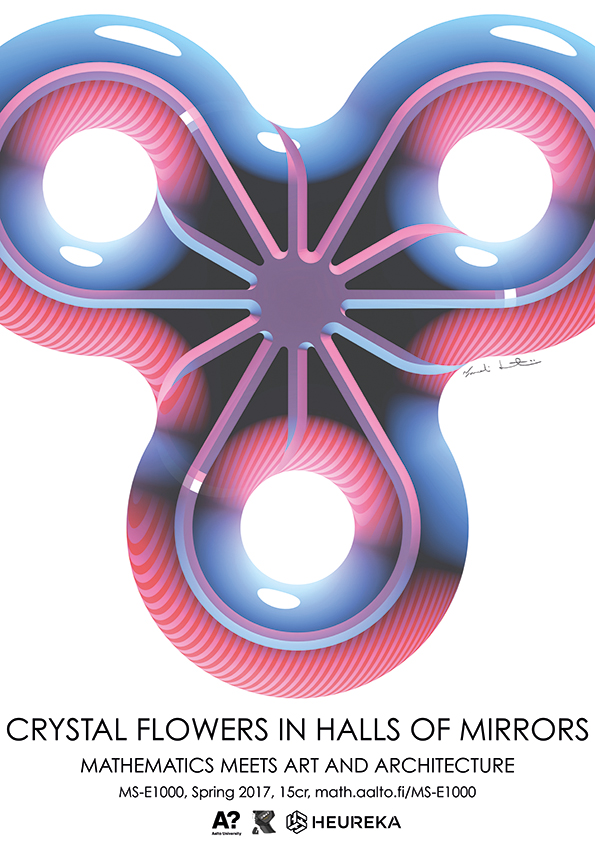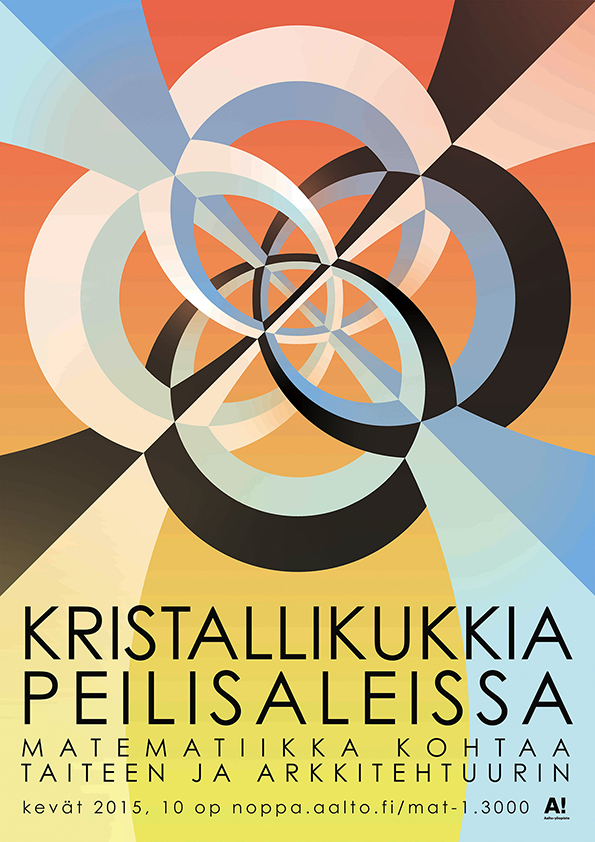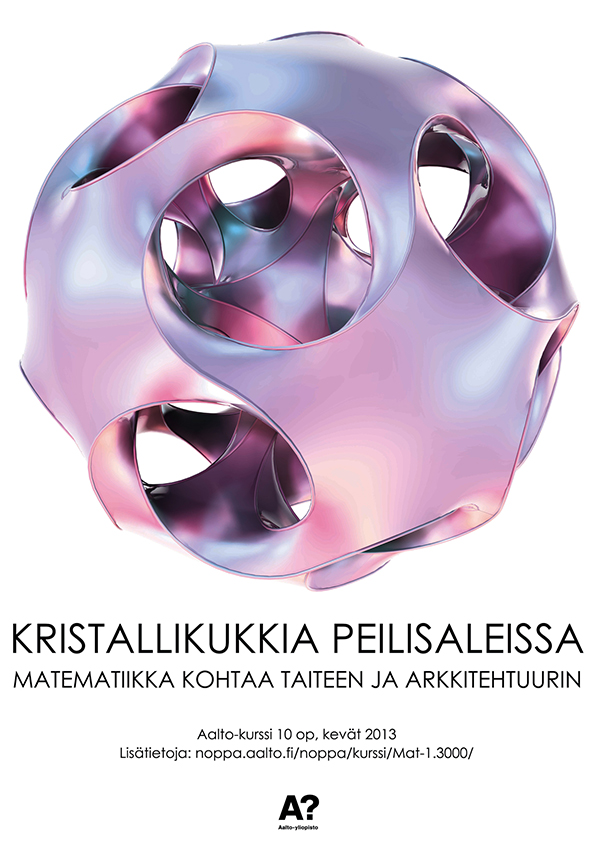
ABOUT
COURSES
WORKSHOPS
EXHIBITIONS
GUESTS
RESOURCES
PHOTOS
NETWORK
CONTACT
AALTO MATH&ARTS MINOR
15-25 ECTS
Language: English
Level: Bachelor, master and doctoral
Professor in charge: Martti Raevaara/ARTS
Contact persons: Senior university lecturer
Kirsi Peltonen and postdoctoral researcher Taneli Luotoniemi
Target group: All Aalto students
Prerequisites: No prerequisities
Content and structure of the minor: The Aalto Math&Arts Minor is designed for students from all schools of Aalto in all levels of education. This systematic approach to engage mathematics and arts is open to students from the other universities in Finland as well. Especially art educators and students from teacher education are highly encouraged to take these courses. School teachers are also welcome to update their skills and find new concrete multidisciplinary ideas for their daily work. Courses can be taken independently, but either (or both) of the 5 ECTS courses below are recommended to be finished before MS-E1000. It is also possible to complete additional independent studies if needed. Contact Kirsi Peltonen in case you are interested in them.
Learning outcomes: Students will learn to find connections between mathematics and art and architecture. Real mathematics will be revealed through patterns, symmetries, structures, shapes and beauty in such a way that will enable the student to view our environment from a new perspective. By the end of the course, the students will be able to distinguish aspects from their own fields which can be presented, considered and developed using the language of modern mathematics.
Application procedure: No separate application procedure
Quotas and restrictions: No quotas or restrictions
Courses and timing:
2026 Fall:
MS-C1001 Shapes in Action, 5 ECTS – period I, every other year
AXM-E0411 - Spatial Structures, Lecture, 6 ECTS – periods I & II
2025 Spring:
MS-E1000 Crystal Flowers in Halls of Mirrors: Mathematics meets Art and Architecture, 15
ECTS - periods III-V, every other year
Fall 2025:
AXM-E0411 - Spatial Structures, Lecture, 6 ECTS – periods I & II
MS-C1001 SHAPES IN ACTION (5 cr)
Level of the Course: Bachelor, Master
Teacher in charge: Kirsi Peltonen
Teaching Period: I (Fall 2026), every other year
Workload: Contact teaching: 6h/week x 6 weeks=36h, Individual/group work: 87h
Grading Scale: 1-5
Learning Outcomes: Students will learn to recognize visual patterns, structures and shapes of our natural and cultural environment, and analyze their symmetries as sets of actions, like rotations, reflections, and transformations. Mathematically rigorous treatment is used to luminate the elegant structures and shapes to an intuitive perspective, and afford the students with a widened scope of possibilities especially within practices
involving modular repetition. By the end of the course, the students will
be able to distinguish aspects from their own fields which can be presented, investigated, and developed using the language of modern mathematics.
Content: Topics on planar, spherical and hyperbolic 2D symmetries, Kleinian groups, conformal dynamics, 3D geometries, manifolds, orbifolds and fractals. This course provides views on research level differential geometry to broad audience. During the course we will consider methods offered by various fields of mathematics which meet needs in art and architecture. Through concrete projects, we will find phenomena and interpretations of these phenomena from both classical and modern mathematics.
Assessment Methods and Criteria: There are no prerequisites from mathematics or art. Students must participate in 80% of the contact teaching. Exercises, workshops, learning diary.
Study Material: To be determined at the beginning of the course.
CRYSTAL FLOWERS IN HALLS OF MIRRORS (15 cr)
Level of the Course: Bachelor, Master, Doctoral level
Teacher in charge: Kirsi Peltonen
Teaching Period: III-V (Spring 2025), every other year
Workload: Contact teaching: 6h/week x 12 weeks=72h, exhibition 36h, independent study: 150h
Grading Scale: 1-5
Learning Outcomes: Students will learn to find connections between mathematics and art and architecture. Real mathematics will be revealed through patterns, symmetries, structures, shapes and beauty in such a way that will enable the student to view our environment from a new perspective. By the end of the course, the students will be able to distinguish aspects from their own fields which can be presented, considered and developed using the language of modern mathematics.
Content: During the course we will consider methods offered by various fields of mathematics which meet needs in art and architecture. Through concrete projects, we will find phenomena and interpretations of these phenomena from both classical and modern mathematics.
Various topics especially from low dimensional topology and geometry. Symmetries and tilings through classifications. Euclidean, spherical and hyperbolic models for geometry. Polyhedrons in low dimensions, geometry of surfaces and orbifolds. Minimal surfaces, ruled surfaces, projections, Hopf fibration and other structures. Ideas from fractal geometry and dynamics. Algorithmic Art. Topics from Kleinian groups and knot theory. Origami and its connections to diverse fields. Artists and architects in related fields from past to present.
Assessment Methods and Criteria: Prerequisites UWAS-C00014 Spatial Structures or MS-C1001 Shapes in action or corresponding knowledge from mathematics and art. Students must participate in 80% of the contact teaching. The course consists of project work completed in groups of at most six people at Aalto Design Factory. All steps of the project: planning, implementation, written reports and presentations will have an impact on grades. Individual input is also taken into account by reflections, portfolios, exercises and essays. Optional forms of completing the course can be provided, if required. A complete evaluation and monitoring of learning is performed during the course.
Study Material: To be determined at the beginning of the course.



AXM-E0411 SPATIAL STRUCTURES (6 cr)
Level of the Course: Bachelor, Master
Teacher in charge: Taneli Luotoniemi
Teaching Periods: I & II
Workload: 24x2 hours = 48h
Individual/group work: 114h
Grading Scale: 1-5
Learning Outcomes: During the course students will learn to understand some of the spatial constraints governing visual making, how they relate to each other, and what are the geometric and topological concepts used to refer to them. The students will learn how to represent structures and spaces in interesting and effective means. They will also learn to recognize and contextualize various geometric and topological phenomena, talk about them using appropriate vocabulary, solve spatial problems arising from their own practice, and know where to find further information about them. Dealing with the properties of polygons, meshes, solids and their projections, many contents of the course are perfect for application in digital technologies such as programming, CAD and 3D printing.
Content: Topics discussed include tilings and patterns, polyhedra, space-fillings, symmetries, projections, perspective, topology, hyperbolic and projective geometries, knots, 4-dimensional space, geometry in fiction, and mathematical art.
Assessment Methods and Criteria: The working methods include lectures, demonstrations, exercises, workshops and discussions. The assessment is based on activity during the meetings and on the exercises, where the focus is on the treatment of the subject, artistic inventiveness, and the articulated and careful execution.
Study Material: The course does not have mandatory reading, but the students are provided with a list of relevant literature and webpages for further inquiries.